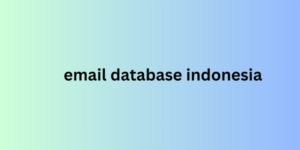Examples of poaching a competitor's clients
Posted: Sun Dec 22, 2024 9:05 am
American author Denis Houptley in his book Something Completely Different notes that the primary task is to understand the motives for using your product by consumers. After that, you should determine the actions that the buyer takes to achieve their goal. At the final stage, you should simplify this process by removing unnecessary steps on their way to receiving the reward. This approach will help increase the speed of the target audience's movement through the sales funnel and simplify their habituation to the product.
An example of this method is the story of email database indonesia Blockbuster and Netflix. Previously, the former was the leader in the film distribution industry, but after the emergence of the latter, which significantly simplified users' access to films, the situation changed. Customers no longer had to go to a rental point, since it became possible to rent films online. By speeding up the passage of the "hook" stages, Netflix was able to displace Blockbuster from the leading position.

Make the product an order of magnitude more valuable
One path to market leadership involves creating a product that is significantly superior to what your competitors offer.
Let's say you receive messages at the same time, one on Snapchat and one on WhatsApp. Which one will you open first? Many will choose the first service. What makes the user experience in this app more attractive?
Examples of poaching a competitor's clients
One of the key features of Snapchat is the automatic “self-destruction” of sent messages after a few seconds. If the recipient does not open the application immediately, he will never be able to read the information received. Thanks to this feature, people can exchange spontaneous (and often compromising) photos, which makes the messages more interesting for the recipient. As a result, Snapchat has a significant advantage over WhatsApp, which allows it to remain in the lead.
Increase the frequency of product use
According to analysts, the number of repeated actions directly affects the rooting of habits. Increasing the frequency of use of your product can be a key factor in the fight for the buyer's attention.
Amazon is a good example of how this approach has been successfully implemented. The well-known marketplace has made shopping more accessible and frequent by allowing people to buy anything they want from the comfort of their home or office. This has made Amazon a one-stop-shop for easy shopping. As a result, the online platform has become the most used and most successful service in the world.
Make it easy to get started with your product
Many habit-forming products are easy to get started with. By removing unnecessary barriers to entry, you can easily attract your competitor's customers.
Let's take Microsoft Office and Google Docs as an example. Google Docs has now become the most widely used product in the world, even though not long ago it was unheard of. How did this happen? People who were previously unfamiliar with Google Docs can instantly use it for free and without installing any software. This makes it much easier to get started with the product and get through the "hook."
An example of this method is the story of email database indonesia Blockbuster and Netflix. Previously, the former was the leader in the film distribution industry, but after the emergence of the latter, which significantly simplified users' access to films, the situation changed. Customers no longer had to go to a rental point, since it became possible to rent films online. By speeding up the passage of the "hook" stages, Netflix was able to displace Blockbuster from the leading position.

Make the product an order of magnitude more valuable
One path to market leadership involves creating a product that is significantly superior to what your competitors offer.
Let's say you receive messages at the same time, one on Snapchat and one on WhatsApp. Which one will you open first? Many will choose the first service. What makes the user experience in this app more attractive?
Examples of poaching a competitor's clients
One of the key features of Snapchat is the automatic “self-destruction” of sent messages after a few seconds. If the recipient does not open the application immediately, he will never be able to read the information received. Thanks to this feature, people can exchange spontaneous (and often compromising) photos, which makes the messages more interesting for the recipient. As a result, Snapchat has a significant advantage over WhatsApp, which allows it to remain in the lead.
Increase the frequency of product use
According to analysts, the number of repeated actions directly affects the rooting of habits. Increasing the frequency of use of your product can be a key factor in the fight for the buyer's attention.
Amazon is a good example of how this approach has been successfully implemented. The well-known marketplace has made shopping more accessible and frequent by allowing people to buy anything they want from the comfort of their home or office. This has made Amazon a one-stop-shop for easy shopping. As a result, the online platform has become the most used and most successful service in the world.
Make it easy to get started with your product
Many habit-forming products are easy to get started with. By removing unnecessary barriers to entry, you can easily attract your competitor's customers.
Let's take Microsoft Office and Google Docs as an example. Google Docs has now become the most widely used product in the world, even though not long ago it was unheard of. How did this happen? People who were previously unfamiliar with Google Docs can instantly use it for free and without installing any software. This makes it much easier to get started with the product and get through the "hook."